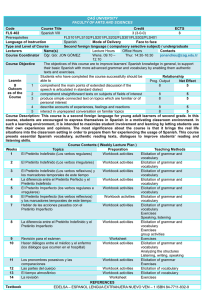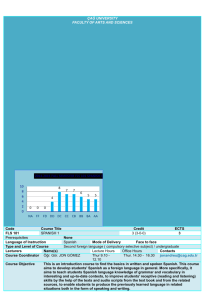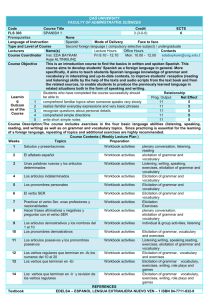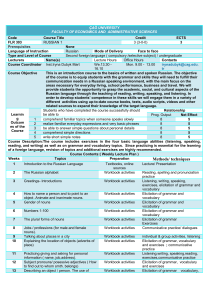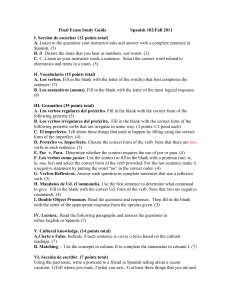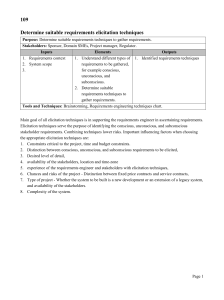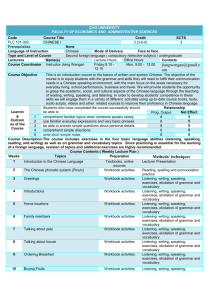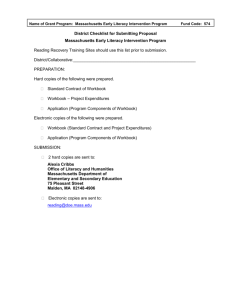Second Foreign Language VIII (Spanish)
advertisement
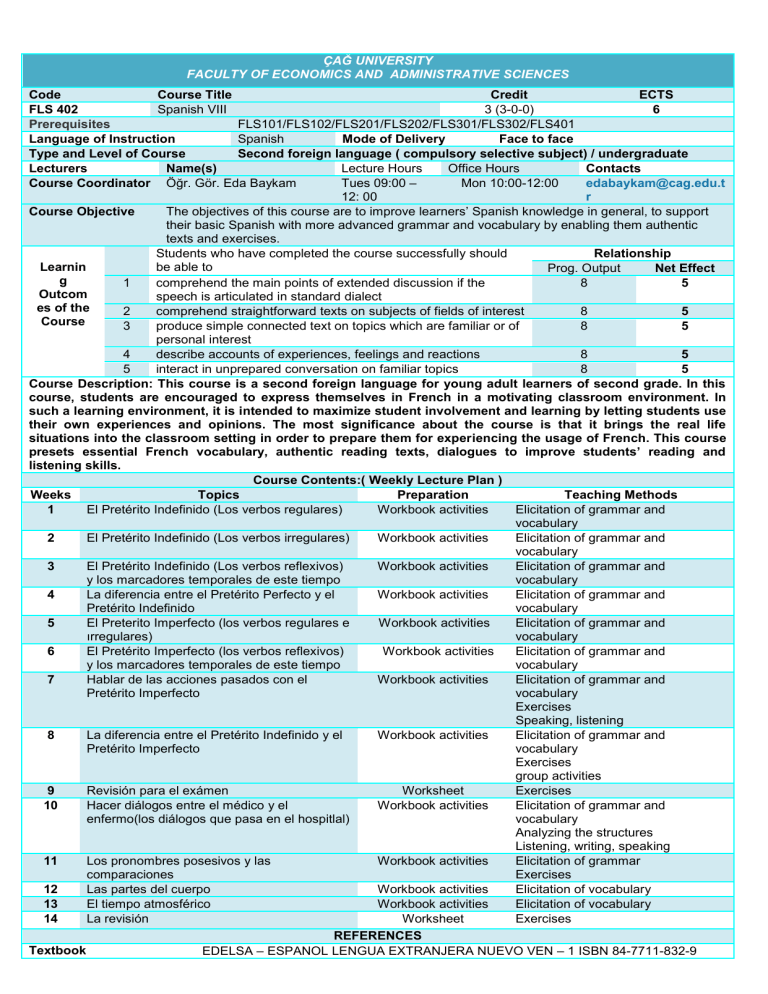
ÇAĞ UNIVERSITY FACULTY OF ECONOMICS AND ADMINISTRATIVE SCIENCES Code Course Title Credit ECTS FLS 402 6 Spanish VIII 3 (3-0-0) Prerequisites FLS101/FLS102/FLS201/FLS202/FLS301/FLS302/FLS401 Language of Instruction Mode of Delivery Face to face Spanish Type and Level of Course Second foreign language ( compulsory selective subject) / undergraduate Lecturers Name(s) Contacts Lecture Hours Office Hours Course Coordinator Öğr. Gör. Eda Baykam edabaykam@cag.edu.t Tues 09:00 – Mon 10:00-12:00 r 12: 00 Course Objective The objectives of this course are to improve learners’ Spanish knowledge in general, to support their basic Spanish with more advanced grammar and vocabulary by enabling them authentic texts and exercises. Relationship Students who have completed the course successfully should Learnin be able to Net Effect Prog. Output g 5 1 comprehend the main points of extended discussion if the 8 Outcom speech is articulated in standard dialect es of the 5 2 comprehend straightforward texts on subjects of fields of interest 8 Course 5 3 produce simple connected text on topics which are familiar or of 8 personal interest 5 4 describe accounts of experiences, feelings and reactions 8 5 5 interact in unprepared conversation on familiar topics 8 Course Description: This course is a second foreign language for young adult learners of second grade. In this course, students are encouraged to express themselves in French in a motivating classroom environment. In such a learning environment, it is intended to maximize student involvement and learning by letting students use their own experiences and opinions. The most significance about the course is that it brings the real life situations into the classroom setting in order to prepare them for experiencing the usage of French. This course presets essential French vocabulary, authentic reading texts, dialogues to improve students’ reading and listening skills. Course Contents:( Weekly Lecture Plan ) Weeks Topics Preparation Teaching Methods 1 El Pretérito Indefinido (Los verbos regulares) Workbook activities Elicitation of grammar and vocabulary 2 El Pretérito Indefinido (Los verbos irregulares) Workbook activities Elicitation of grammar and vocabulary 3 El Pretérito Indefinido (Los verbos reflexivos) Workbook activities Elicitation of grammar and y los marcadores temporales de este tiempo vocabulary 4 La diferencia entre el Pretérito Perfecto y el Workbook activities Elicitation of grammar and Pretérito Indefinido vocabulary 5 El Preterito Imperfecto (los verbos regulares e Workbook activities Elicitation of grammar and ırregulares) vocabulary 6 El Pretérito Imperfecto (los verbos reflexivos) Workbook activities Elicitation of grammar and y los marcadores temporales de este tiempo vocabulary 7 Hablar de las acciones pasados con el Workbook activities Elicitation of grammar and Pretérito Imperfecto vocabulary Exercises Speaking, listening 8 La diferencia entre el Pretérito Indefinido y el Workbook activities Elicitation of grammar and Pretérito Imperfecto vocabulary Exercises group activities 9 Revisión para el exámen Worksheet Exercises 10 Hacer diálogos entre el médico y el Workbook activities Elicitation of grammar and enfermo(los diálogos que pasa en el hospitlal) vocabulary Analyzing the structures Listening, writing, speaking 11 Los pronombres posesivos y las Workbook activities Elicitation of grammar comparaciones Exercises 12 Las partes del cuerpo Workbook activities Elicitation of vocabulary 13 El tiempo atmosférico Workbook activities Elicitation of vocabulary 14 La revisión Worksheet Exercises REFERENCES Textbook EDELSA – ESPANOL LENGUA EXTRANJERA NUEVO VEN – 1 ISBN 84-7711-832-9 Related links Course Notes Recommended Reading Material Sharing Activities Midterm Exam research Homework Effect of The Activities Effect of The Final Exam Contents Hours in Classroom Hours out Classroom Homeworks Research Midterm Exam Final Exam ESPANOL 2000 , NIVEL INICIAL (LIBRO DEL ALUMNO), SGEL, MADRID , CUMBRE SGEL- ISBN 84-7143-511-X, SPANISH GRAMMER-HILL PUBLISHING COMPANY, ISBN 0-07-0554-37-4 worksheets Number 1 1 1 ASSESSMENT METHODS Effect 30% 5% 5% 40% 60% ECTS TABLE Number 14 14 3 3 1 1 Notes Hours 3 3 10 9 17 20 Total Total / 30 ECTS Credit RECENT PERFORMANCE Total 42 42 30 27 17 20 178 =178/30=6 6 MAN 307 BUSINESS FINANCE LEARNING GOALS 1. Be able to define Finance and the role of Financial Manager and to explain how financial markets and institutions channel savings to corporate investment. a. Give examples of investment and financing decisions that financial managers make b. Distinguish the difference between real and financial assets c. Cite some of the advantages and disadvantages of organizing a business as a corporation d. Describe the responsibilities of the CFO, treasurer, and controller e. Explain why maximizing market value is the logical financial goal of the corporation f. Explain why maximization is usually consistent with ethical behavior g. Explain how corporations mitigate conflicts and encourage corporate behavior h. Know the basic functions of the corporations and the role of the corporations in financial markets i. Explain the functions of financial markets & financial institutions j. Define the basic financial assets traded in financial markets k. Define the actors of financial markets: financial institutions l. Use the cost of capital concept for individual and for corporate investment in financial markets 2. Be able to differ the type of interest rates and calculate FV of money invested, PV of a future payment, annuities and set the Cash Flow. a. Define interest and understand the time value of money b. Know the types of interest and its basic components c. Use to set up cash flow diagram d. Practice by using simple interest tecniques e. Learn to use compounding formulas f. Calculate FV of an initial investment and a series of cash payments g. Apply the calculation techniques to real life problems h. Define the PV (Present Value) concept and differ it from FV i. Know the concept of discounting and the difference from interest j. Use to set up cash flow diagram k. Learn to use discounting formulas l. Calculate PV of a future payment and a series of cash payments m. Apply the calculation techniques to real life problems 3. Be able to explain the chracteristics and types of Bonds and calculate the market price of a bond given its yield to maturity and vice versa. a. Define a bond and know basic characteritics and the types of bonds b. Distinguish among a bond’s coupon rate, current yield and yield to maturity c. Show why bonds exhibit interest rate risk d. Understand why investors pay attention to bond ratings e. Calculate the market price of a bond given its yield to maturity f. Finsd a bond’s yield given its price g. Demonstrate why prices and yields vary inversely 4. Be able to explain the chracteristics and types of Stocks and to use basic Stocks Valuation Methods a. b. c. d. e. Define a stock and recall basic characteritics and the types of stocks Understand the stock trading reports in the financial pages of newspapers and other media Calculate the PV of a stock given forecasts of the future dividends and future stock price Use the stock valuation formulas to infer the expected rate of return on a common stock Interpret price/earnings ratios 5. Be able to demonstrate the basic rules of Risk, Return and Opportunity Cost of Capital. a. Measure and interpret the market risk, or beta of a security b. Relate the market risk of a security to the rate of return that investors demand c. Calculate the opportinity cost of capital for a project 6. Be able to use Evaluation Techniqes in Capital Budgeting and to apply on projects. a. Calculate the net present value of an investment (NPV) b. Calculate the internal rate of return (IRR) and to look out for when using it c. Explain why the payback rule doesn’t always make shareholders better off. d. Calculate the profitability index and use it to choose between projects when funds are limited 7. Be able to explain the fundamentals of Corporate Financing. a. Explain why managers should assume that the securities they issue are fairly priced b. Describe the major classes of securities sold by the firm c. Summarize the changing ways that Turkish Firms have financed their growth 8. Be able to calculate WACC and use it for Company Valuation a. Calculate a firm’s capital structure b. Estimate the required rates of return on the securities issued by the firm c. Calculate the weighted-average cost of capital d. Understand when WACC is or isn’t the appropriate discount rate for a new project e. Use WACC to value a business given forecasts of its future cash flows
